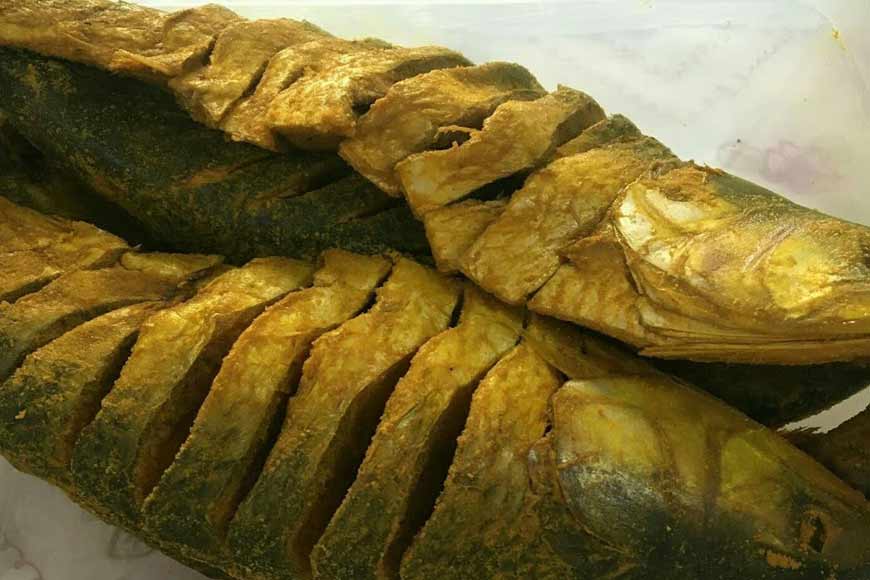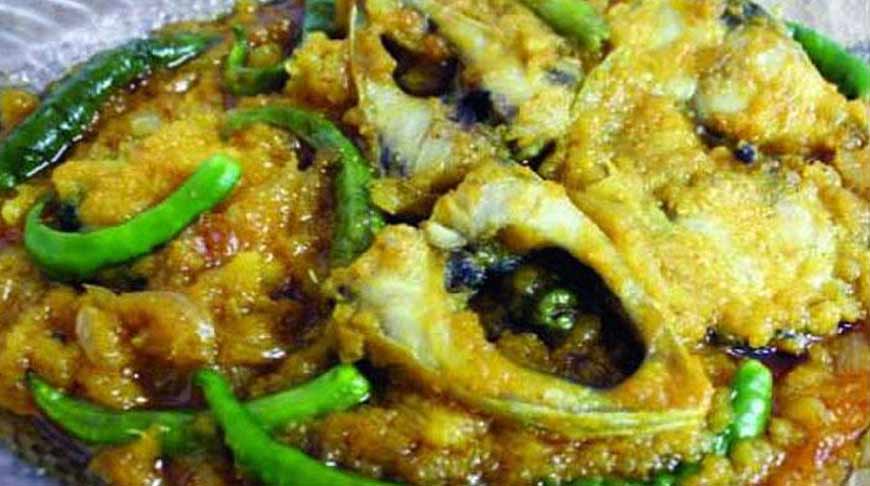Nona Ilish, the Ilish that we never talk about

As the Queen of Fish reigns Bengali kitchens during monsoon, flooding the markets in abundance, a Dried Hilsa form is often ignored. But Nona Ilish has been an age-old form of the Hilsa that has been considered one of the most pricey fishes on either side of the Bengal divide. Rather Nona Ilish still survives in Bangladesh and Tripura, unlike West Bengal, where Shutki or dried fish is synonymous with smaller fishes and not Ilish in general.
Nona Ilish is a dried form of Hilsa Fish. Nona means Salted and Ilish stands for Hilsa. Dried Hilsa preserved with salt is a delicacy popular in Bangladesh even today. This is equally popular in the North-Eastern states of India, especially Tripura. Hilsa is preserved with loads of salt and no added synthetic preservatives. This is an age-old process of preserving fish. The process also helps pack in the flavour critical to the sensory experience.
The Nona Ilish season coincides with monsoon, typically August-September, when the catch is abundant. In Chandpur, the unofficial Hilsa capital of the world, it is a full-fledged industry. The fish is gutted, and its scales and fins are removed. It is then cut and marinated with rock salt and turmeric as well as its own fat, extracted from the entrails. The pieces are left to cure underground in earthen jars for several months. The fermentation process breaks down the proteins, fatty acids and lipids, resulting in a characteristic aroma. It also creates an amber gold liquid byproduct known as nonar-tel (a kind of fish oil). Mainstream Ilish recipes usually ignore Nona Ilish and rather encourages to cook this fish fresh. But the salty and cured variation has an overpowering scent. Today, Nona Ilish tends to be confined to the kitchens of those who migrated from East Bengal, and Bengalis who have been living in Tripura for generations.
Rajendranandini Dasgupta who has her roots in East Bengal, says: “Nona Ilish has a very strong aroma. Ilish anyway is famous for its aroma. However, a preserved fish aroma is different. In my household when my grandmother used to cook Nona Ilish, we all screwed our noses. But once you taste it, I can vouch that it is heavenly. We have relatives in Tripura and they prepare curry and chutneys from this form of Ilish. They call it Luna Chutney and Luna-r tarkari.”
Also read : Ilish recipes from Narayanganj and Barishal
But Nona Ilish has a special way of preparation. As it has high salt content, the fish is soaked well in water before cooking. Then it is dried and cut to small pieces and stir-fried with onions and green chillies. Another recipe is Nona Ilisher bora where the fish is stuffed in gourd leaves, smeared in rice-flour batter and shallow-fried. The Nona Ilish-er dim or eggs are equally prized. They can be cut into chunks and stir-fried with sliced onions and green chillies. Or cooked into a stew-like dish, called tawk with tamarind. But beware of the pungent odour!

Try the following recipe of Nona Ilish
Before cooking:
Soak the fish chunks in water for 30 minutes.
Dice Onion and garlic to cover the raw smell.
Use Mustard Oil as a cooking agent as it goes perfectly with dry fish.
INGREDIENTS
| Nona Ilish/ Dried Hilsa Fish: | 5 pieces |
| Onion: | 5 |
| Ginger Paste: | 1 Tbsp. |
| Garlic Paste: | 2 Tbsp. |
| Chopped Garlic: | 1/2 Tsp. (optional) |
| Green Chili: | 5-6 |
| Coriander Powder: | 1/2 Tsp |
| Turmeric Powder: | 1/2 Tsp. |
| Red Chili Powder: | 1/2 Tsp. |
| Salt: | to taste |
| Mustard Oil: | 4 Tbsp. |
Procedure
● Heat Mustard oil in a pan
● Fry Onion till brown
● Add Ginger and Garlic paste and cook till oil comes out from the mixture
● Add chopped Garlic and chopped Green chili followed by Coriander powder, Turmeric Powder, Red Chili, and powder
● Add water and boil
● Add fish chunks and cover the pan. Cook on low flame
● Give 1 tablespoon of Mustard Oil on the top










